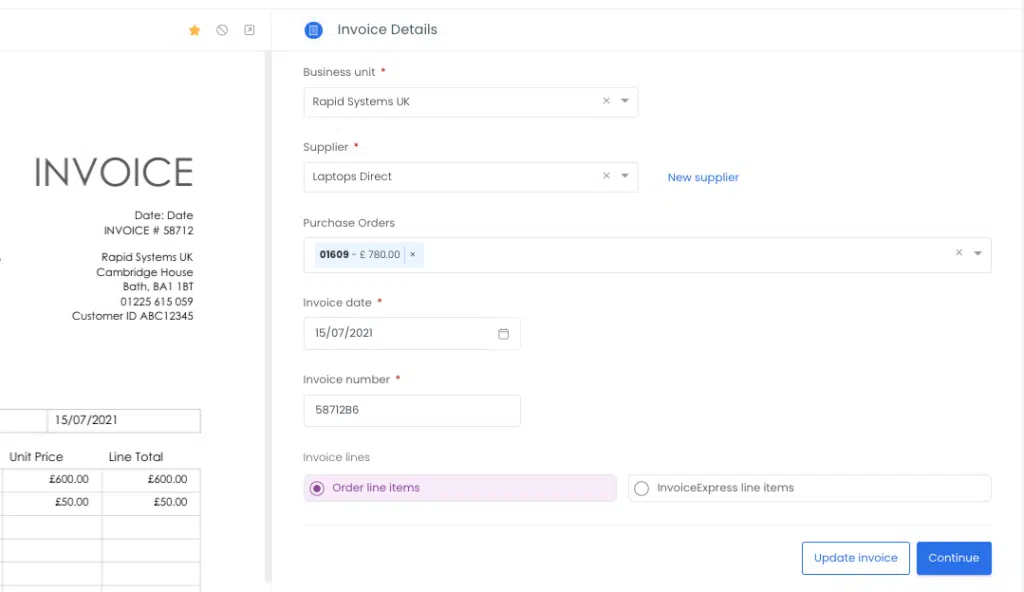Business Unit Category
Add an email signature
Coding Restrictions
Create new Business Unit
Custom Fields on Line Items
Customised labels
Date formating
Default delivery address
Division Management
Editing Email Templates
How to hide cost codes
Invoice email forwarding – Microsoft 365
Pros and Cons of Using Zahara’s Inbuilt Email Service vs. Your Own SMTP
SMTP & Email Sending
T&C on your PO Template
Invoice Processing Help Category
Auto reject supplier invoices
Auto rejecting of invoices issue
Finding an order or invoice
How to create a credit note
Invoice email forwarding – Microsoft 365
Invoice export colours
Invoice Inbox
Invoice List View
Invoice matching
Invoice Processing Explained
Month end cut offs
Negative Order Balance
Setting up Autopilot
Supplier Matching
Waiting for a GRN
Purchase Orders Category
Adding a product to an order
Adding documents to an order
Bulk importing orders
Close Orders Automatically
Closing an order
Copy PO to Buyer
Creating a Purchase Order
Deleting a PO
Duplicate Order Prevention
Editing an order
Finding an order or invoice
GRN an Order – Learn with this Guide
Grouped Purchase Orders
Import Line Items
Negative Order Balance
PO Template Editing
Product Centric Buying
Purchase Order Numbering
Purchase Order PDF
Purchase Order Prefix
Purchase Requisition Number
Quick Create a Purchase Order
Send PO to Supplier
Supplier order acceptance
What is a Purchase Order?
With Zahara, you can raise purchase orders and you can record invoices. You can of course link the two together and show the difference between the order and the invoice. Zahara also has receipting (GRN) data so there is effectively a three-way match. Because of the nature of the customers that use Zahara – mainly service-based businesses, we aren’t a stock control system. Zahara is designed to be easy to use and if anything, will always try and take a simpler approach where possible.
The process for matching orders and invoices is as follows:
The invoice Inbox is the starting place for all Invoice processing. We will assume here that an invoice has been read and you are ready to process it. You select the order number from a list of outstanding orders for the selected supplier or confirm the order number if the order number is referenced on the invoice, as shown below:

With the supplier correctly identified, any outstanding purchase orders will be available in the Purchase Orders select list. The invoice may relate to multiple purchase orders. You can select one or more in this field. If the OCR engine is successful (its expected to be), the purchase order number will be pre-selected in this field, if it is referenced on the invoice
This is an essential point of Zahara’s functionality. Where an invoice and order differ – you have to adjust the order line items to reflect the invoice. We don’t do this automatically. The Order lines are the truth – this is what you have created and now the supplier has invoiced you, you need to reflect the invoice in the order lines.
As an example. You have 3 order lines as shown below and this went off to the supplier. In an ideal world, the supplier would send you an invoice that exactly matched this.
However, the supplier has sent an invoice as shown:
You now have to reflect this when creating the invoice. You could create a stand alone invoice, with no link to the order. Your order would be orphaned though. What you need to do is create the invoice, select the order it relates to and then adjust the three lines as shown below:
The other point to mention here is that when you are recording the invoice, and using the Order lines, you have the ability to change the coding as well. It could be you need to change the nominal code to assign the invoice to a Project. This is all possible at this stage but doesn’t affect the matching balance.
Each order and invoice has an overall order invoice balance. When the original order was raised, the balance was £448.80 – ie we are in credit by £448.80.
After the first invoice is received, the balance is now £404.12 – the original order value, less the first invoice.
In terms of the line balances, this would be as shown below:
As you can see, we are trying to get to a balance of zero where the order matches the invoices received against it.
The line item balances will be available to view on both the order and the invoice.
You can create an invoice from the + > Invoice menu and populate all fields yourself. You then select the purchase order that the invoice relates to from the list of available PO numbers in the select list.
Notice the “Import Purchase Order Line Items” in blue. You have to click this link to pull through the Order lines. You will also notice that we show in the Purchase Order select list any orders that are awaiting approval –
Once the order lines are imported to the line items, you complete the Invoice create using the method above to adjust any lines to reflect the invoice received.
Zahara has a number of reports that can be used to help you calculate the overall Purchase Order Invoice Difference. We have a report of this name, in the Purchase Orders section of our reporting, that can be run which will give you the balance of all orders and invoices. This is a non-line item-level report so won’t provide the granularity of where the balances lie.
Advanced Reporting
You can use the Zahara reporting API to connect to the order, invoices and line-items data source in Excel (or PowerBI). The swagger file – https://data-api.myzahara.net/swagger/index.html shows the data sets available and the field. The balance is available on the Line Items table.
Please read the Advanced Reporting help guide or submit a support ticket to have your Zahara account enabled.